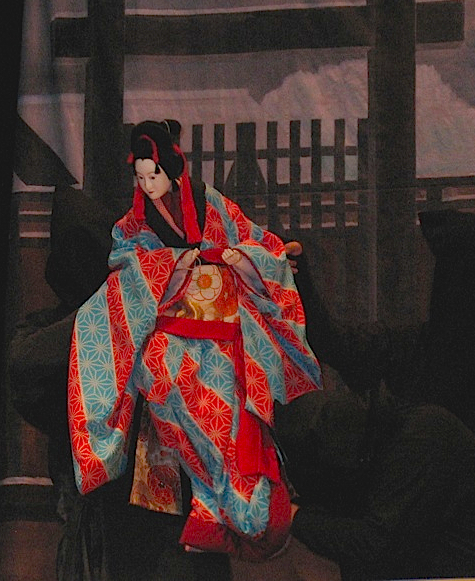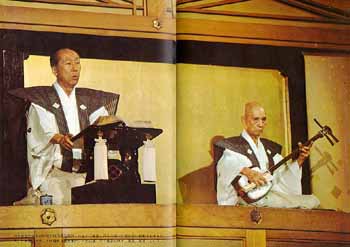Bunraku
 Japan
has a centuries-old tradition of itinerant storytellers who chanted works of
vocal literature, often associated with folk religion or Buddhist teachings, to
the accompaniment of a stringed lute or biwa (琵琶).
Puppeteers who served as traveling entertainers providing rural communities with
a sense of ritual purification and renewal also have a long history in many
parts of Japan. These two forms of popular entertainment contributed to the
development of a performing art known as ningyō jōruri (人形浄瑠璃),
directly translated as puppet storytelling, or ningyō
shibai (人形芝居),
puppet plays. The term bunraku comes from the name of a puppet
theater in Osaka, the Bunrakuza, associated with the refinement and promotion of
the puppet theater in the late nineteenth century. The characters used to write
the term bunraku (文楽)
mean the delight (raku) of literary arts (bun).
Bunraku derives its magic from the precise juxtaposition of arts that are
both theatrical (dramatic staging, costumes, musical performance, and puppetry) and
literary (storytelling and the chanting of prose) in nature. The visual and aural
components of bunraku comingle to provide audiences with a powerful
dramatic experience that is unique among premodern performing arts. In
most bunraku performances today a single chanter (tayū)
recites and sings the parts for all the characters in the play, altering the
pitch and quality of song to give each character a recognizable voice. The
tayū not only chants the lines of the puppets on stage, but also
provides narration that brings a literary text to life for the audience. The
player of a three-stringed instrument called a samisen, is seated next
to the chanter. The samisen player often provides sound effects as well as
musical accompaniment to the tayū's performance.
Coordination of the tayū and samisen roles requires such complex
synchronization and collaborative finesse that most professional chanters and
samisen artists work exclusively as a team for the duration of their careers. The tayū and samisen player (and
occasionally other musicians, such as a drum player) are seated on a revolving
platform. In longer performances the platform is rotated to bring
replacement musicians onto the stage without interrupting the flow of the
dramatic performance.
Japan
has a centuries-old tradition of itinerant storytellers who chanted works of
vocal literature, often associated with folk religion or Buddhist teachings, to
the accompaniment of a stringed lute or biwa (琵琶).
Puppeteers who served as traveling entertainers providing rural communities with
a sense of ritual purification and renewal also have a long history in many
parts of Japan. These two forms of popular entertainment contributed to the
development of a performing art known as ningyō jōruri (人形浄瑠璃),
directly translated as puppet storytelling, or ningyō
shibai (人形芝居),
puppet plays. The term bunraku comes from the name of a puppet
theater in Osaka, the Bunrakuza, associated with the refinement and promotion of
the puppet theater in the late nineteenth century. The characters used to write
the term bunraku (文楽)
mean the delight (raku) of literary arts (bun).
Bunraku derives its magic from the precise juxtaposition of arts that are
both theatrical (dramatic staging, costumes, musical performance, and puppetry) and
literary (storytelling and the chanting of prose) in nature. The visual and aural
components of bunraku comingle to provide audiences with a powerful
dramatic experience that is unique among premodern performing arts. In
most bunraku performances today a single chanter (tayū)
recites and sings the parts for all the characters in the play, altering the
pitch and quality of song to give each character a recognizable voice. The
tayū not only chants the lines of the puppets on stage, but also
provides narration that brings a literary text to life for the audience. The
player of a three-stringed instrument called a samisen, is seated next
to the chanter. The samisen player often provides sound effects as well as
musical accompaniment to the tayū's performance.
Coordination of the tayū and samisen roles requires such complex
synchronization and collaborative finesse that most professional chanters and
samisen artists work exclusively as a team for the duration of their careers. The tayū and samisen player (and
occasionally other musicians, such as a drum player) are seated on a revolving
platform. In longer performances the platform is rotated to bring
replacement musicians onto the stage without interrupting the flow of the
dramatic performance.
 A
unique characteristic of bunraku, as
opposed to puppetry of other cultures, is the technique known as
sannin-zukai (three puppeteers) in which a single puppet is manipulated by
three puppeteers. The puppeteers are usually clothed entirely in a black
performing costume (kurogo) so that their movements are unrestricted
yet their presence on stage does not serve as a distraction to the audience.
Each puppeteer focuses on the controlled movement of part of the puppet and
associated props with coordination so exacting that the range of expression and
movement is as nuanced, fluent, and subtle as that of a human actor, but without
the limitations of human form. It is not surprising that the greatest dramatist of premodern Japan, Chikamatsu Monzaemon (1653-1725), established his reputation
with plays written for the puppet theater and continued to favor the puppet
theater throughout his career. While the puppet theater is often
considered a form of entertainment for children, bunraku continues
today as a theatrical art designed to engage the sensibilities of a
sophisticated adult audience.
A
unique characteristic of bunraku, as
opposed to puppetry of other cultures, is the technique known as
sannin-zukai (three puppeteers) in which a single puppet is manipulated by
three puppeteers. The puppeteers are usually clothed entirely in a black
performing costume (kurogo) so that their movements are unrestricted
yet their presence on stage does not serve as a distraction to the audience.
Each puppeteer focuses on the controlled movement of part of the puppet and
associated props with coordination so exacting that the range of expression and
movement is as nuanced, fluent, and subtle as that of a human actor, but without
the limitations of human form. It is not surprising that the greatest dramatist of premodern Japan, Chikamatsu Monzaemon (1653-1725), established his reputation
with plays written for the puppet theater and continued to favor the puppet
theater throughout his career. While the puppet theater is often
considered a form of entertainment for children, bunraku continues
today as a theatrical art designed to engage the sensibilities of a
sophisticated adult audience.
Imada Puppet Theater
The Imada Puppet Theater traces
its history back to 1704, when villagers near the banks of the Tenryu River in southern Nagano Prefecture acquired puppets
to use in offertory performances at the local Shinto shrine. In the ensuing
years, the puppeteers developed performances of the secular plays that
originated in the Osaka puppet theater and spread throughout the country. By
the mid-1800s, the Imada puppeteers and musicians
were traveling throughout the region to perform.
Having survived the lean War years with only a tiny handful of performers, the Imada Puppet Theater has emerged in recent decades as one of the most active and respected regional puppet troupes in Japan. The Imada Puppet Theater has performed abroad in Taiwan, France, and the United States. The Imada Puppet Theater is also dedicated to nurturing the next generation of performers and audiences, offering training programs in puppet manipulation, samisen playing, and chanted narration that draw large numbers of committed young people in local schools to the ancient art form.
Headed by Tamon Sawayanagi, the Imada Puppets rehearse and perform regularly in their own theater, built new in 1994 and expanded last year, which is located on the grounds of the Hachiman Shrine in the Tatsue area of the city of Iida.
Four members of the Imada Theater are touring the US in 2009. Director Tamon Sawayanagi (puppeteer), Fumiko Kinoshita (puppeteer), Yukihiko Kinoshita (samisen player and puppeteer), and Ryuzo Matsuo (tayū chanter and puppeteer). They will be joined by puppeteers from the Bunraku Bay Puppet Troupe of Columbia, Missouri, most of whose members received their training at the Imada Puppet Theater. The 2009 tour includes performances at Willamette University in Oregon, the University of Colorado, and the University of Missouri, in addition to Princeton University.
Program Notes
Kotobuki
Shiki Sanbaso 寿式三番叟 A celebratory
dance piece of divinely-inspired puppetry that originated in masked Noh drama,
the Sanbaso is meant to who purify the theater and
scatter good fortune with lively gestures. But even a puppet charged with the
solemn task of blessing an audience sometimes gets tired and needs to cool off
after a taxing turn on the stage.
Puppetry demonstration. Puppeteers and
Musicians provide a “behind-the-scenes” look at the workings of the puppets and
features of the music of the traditional theater.
Yaoya Oshichi 八百屋お七 火の見櫓の段 Oshichi, daughter of the greengrocer, must relay secret
information to her lover within hours or he will die. But on this snowy evening, the gates of the city already secured for the night, she cannot get
to him. Passing near a fire tower, Oshichi realizes
that all the gates will be opened if a fire alarm is sounded. But the penalty
for sounding a false alarm is death. Oshichi chooses
to climb the icy tower steps to ring the bell, a testament to her devotion to
her love.
Lion
Dance 獅子舞 Lion Dance is a piece performed throughout
East Asia in a variety of forms. The lively and engaging Lion Dance brings good
fortune to the audience--a lion bite on the head will confer intelligence on
children and good health for the coming year. But the lion himself is not
always so fortunate. His slumber is often disturbed by delicate but pesky
visitors.
Hidakagawa Iriaizakura 日高川入相花王 渡場の段
Kiyohime is in love with a young man who will not return
her affection. In the scene at the crossing of the Hidaka River, Kiyohime entreats a boatman to ferry her across as she
pursues the object of her obsession. But the grumpy boatman has been paid by
the young man not to comply with Kiyohime’s wishes.
Ridiculed by the boatman for her desires, Kiyohime
becomes enraged when she learns the story of her intended love’s
infidelity. Her demonic jealousy
transforms both her heart and her form in ways that frighten the crusty boatman
and ultimately spell doom for the hapless young man she pursues.
Members of Imada
Puppet Theater
Tamon Sawayanagi,
Puppeteer and Head of the Troupe
Fumiko Kinoshita, Puppeteer
Ryuzo Matsuo, Puppeteer and Tayū
Yukihiko Kinoshita, Puppeteer and Samisen
Player
Members of Bunraku
Bay Puppet Theater
Martin Holman, Puppeteer
and Director
Vince Lobello, Puppeteer and Technical
Director
Aaron Jasny, Puppeteer and Samisen Player
Taylor Morrow, Puppeteer and Tayū
Andrew Cooper, Puppeteer
Eric Schlossberg
'10, Puppeteer
Amanda Holman, Puppeteer and Tayū
Stacey Polishook, Puppeteer
Cody Reed, Puppeteer